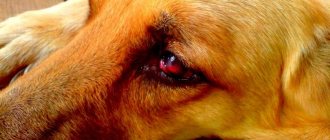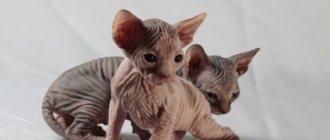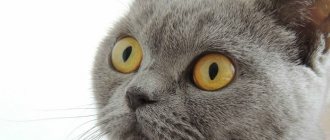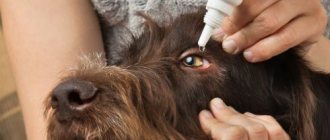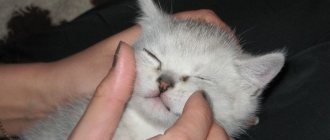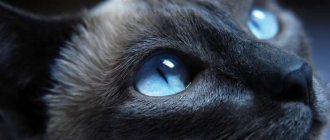Often the owners of these miniature dogs note that their Chihuahuas have watery eyes. In general, this is a normal situation - the dog’s eyes are very large, bulging, and need frequent moisturizing.
Tear fluid washes the outer part of the eyeball, preventing it from drying out. If the discharge is colorless, odorless and suppurative, there is no need to worry. A few simple cosmetic manipulations are enough to remove tear tracks on the animal’s face.
Causes of watery eyes in Chihuahuas
A small amount of clear discharge from the eyes is normal for Chihuahuas. Alarming symptoms include an increase in the number of tears, the appearance of an unpleasant odor, and cloudy mucous discharge. There can be several causes of tearing, from harmless ones that can be treated at home to serious illnesses that require a visit to the veterinary clinic.
Foreign body
Often, while walking, small debris, wool, and even insects get into the animal’s eyes. When a foreign body penetrates, fluid is released from the affected organ. In this case, it is necessary to rinse the eye with saline solution or chamomile infusion. After removing the foreign object, you need to take the dog for examination to a veterinarian to eliminate the possibility of injury to the cornea of the eye and, as a result, the development of inflammatory processes.
The dog closes his eye that is bothering him
Poor nutrition
One of the most common causes of increased lacrimation in Chihuahuas. Sweets that the dog actively begs for and receives, and foods rich in carbohydrates, lead to the fact that the animal’s eyes water without stopping. Carbohydrates are found in large quantities in potatoes, baked goods, cereals, sweets and cakes. To get rid of increased tearing, it is enough to exclude a variety of “snacks” from the dog’s diet and replace them with healthy foods and vegetables.
Feeding your Chihuahua should never be taken from your table.
Entropion of the eyelids
With this problem, the hair constantly irritates the cornea of the eye, causing excessive fluid secretion. Entropion of the eyelids can be a congenital pathology or appear as a result of injury. To alleviate the animal’s condition, it is better to contact a veterinarian. He will be able to assess the extent of the problem and recommend procedures to improve the situation.
Allergy
One of the common causes of increased lacrimation. Allergies can occur both to substances that come into contact with the cornea of the eye (pollen, dust, deodorant or spray), and to the foods that the animal eats.
If an allergy is suspected, it is necessary to remember and write down all new substances and products that the dog came into contact with before the onset of symptoms. This information will be useful to the doctor when making a diagnosis. After the visit to the doctor, you will have to give the dog prescribed antihistamines for some time. You should also, if possible, avoid contact of your pet with possible allergens.
Eye examination by a veterinary ophthalmologist
Impaired fluid circulation
With this pathology, the outflow of tears is disrupted or the animal’s body produces too much fluid. Only a veterinarian can give a conclusion about an outflow disorder after conducting a Schinmer test.
Inflammation
An inflammatory process in the eye can be caused by parasites or viruses. These problems lead to the development of conjunctivitis and, as a consequence, to the appearance of purulent discharge and oxides. The animal's eye appears red and swollen. Tears and mucus are released almost continuously.
Treatment consists of eliminating the cause and relieving the inflammatory process. During the treatment period, it is a good idea to carefully rinse the eye with saline solution or lotion to prevent the appearance of a dried crust that can further injure the eye.
Infection
The most dangerous condition, accompanied by profuse lacrimation. If excessive tear production is accompanied by lack of appetite, photophobia, lethargy or fever, you should immediately consult a doctor. Some infections develop so rapidly that they can lead to the death of an animal within 2-3 days.
Blepharitis is an infectious disease that is often diagnosed in Chihuahuas.
Cough and sneeze
If your Chihuahua has a persistent, paroxysmal cough that makes it seem like your pet is choking on something, this may be a symptom of tracheal collapse.
This pathology, in which the trachea narrows due to soft tissue, can be congenital or acquired as a result of obesity or lack of physical activity.
Drug treatment of the inflammatory process leading to tracheal collapse is carried out strictly under the supervision of a veterinarian.
If the disease is caused by obesity, you will additionally need to follow a fasting diet.
We suggest you read: Discussing the brand of yam food for cats and kittens
Also, a cough, especially coupled with sneezing, can be caused by an allergy, cold or viral infection.
Read about other causes of cough in Chihuahuas here.
Eye diseases in Chihuahuas accompanied by lacrimation
Due to the anatomical features of the Chihuahua's eyes, they are most often susceptible to various diseases. Lack of treatment or late diagnosis can lead to complete and irreversible loss of vision.
Among the most common eye diseases inherent in this breed are:
- glaucoma;
- cataract;
- keratoconjunctivitis.
Glaucoma in Chihuahuas can develop against the background of inflammatory processes in the eye or as an independent disease. This pathology is caused by increased intraocular pressure and, as a consequence, impaired fluid circulation. As the disease progresses, it causes a decrease in visual acuity followed by complete blindness.
Measuring intraocular pressure
The first symptom of glaucoma is excessive watery eyes. As the disease progresses, greenish discharge appears from the eyes. The eyeball begins to increase in size. At the initial stages this is barely noticeable, but in its acute form it is clearly visible even to a layman. A network of blood vessels is visible on the white of the eye. Sometimes, due to rupture of blood vessels, the protein becomes covered with blood.
The acute form of glaucoma is accompanied by severe pain. Due to constant pain, the animal becomes lethargic and avoids bright light.
There is no cure for glaucoma, but you can stop the process before your dog loses his vision completely. Treatment consists of instilling special drops to reduce intraocular pressure. Only a veterinary ophthalmologist can make a diagnosis and prescribe treatment.
Advanced glaucoma
Symptoms of cataracts are difficult to notice early in the development of the disease. The main symptom is decreased vision and increased lacrimation. As the disease progresses, the lens of the eye becomes cloudy, which is noticeable to the naked eye.
If signs of cataracts appear, you must immediately consult a doctor, since this disease in most cases is accompanied by the development of glaucoma and also leads to complete blindness. Cataracts can only be treated with surgery.
Cataract
Keratoconjuntivitis is accompanied by the appearance of greenish purulent discharge from the eyes. The dog often rubs its eyes with its paws, trying to get rid of uncomfortable sensations. The dog blinks frequently. The pupils become dull and dull, and ulcers appear. At the initial stages, the decrease in vision is not too noticeable, since the animal compensates for this loss with a keen sense of smell.
Purulent discharge from the eye
Skin problems
| Disease | Symptoms | Causes | Treatment |
| Fleas | It is almost impossible to determine the presence of parasites visually; the main sign of their appearance is the behavior of the dog. The animal becomes nervous, constantly itches, and tries to bite fleas out of its fur. Often, inflammation and ulcers appear at the sites of bites, and hair falls out on them. | Fleas feed on the blood of dogs and live in their fur in search of food. The main source of infection is the street or contact with infected animals. |
|
| Atopic dermatitis | Similar to the symptoms of food allergies, but more often limited only to skin itching | A genetic disease characterized by susceptibility to environmental allergens (dust, pollen, mold, etc.) that can enter the body through the lungs or skin, bypassing the gastrointestinal tract | The only way to cope with atopic dermatitis is to choose a place for your pet to live with a minimum number of allergens. |
| Scabies |
| The causative agent of the disease is scabies mite | Treatment is prescribed by a veterinarian. It may consist of a course of injections or external agents - ointments, creams. The house must be thoroughly cleaned; the bedding on which the dog slept must be destroyed or at least disinfected |
| Hair loss | Unseasonal, heavy and uneven hair loss | This may be due to the dog overheating, frequent washing, stress and nervous condition of the pet, poor diet, lack of vitamins and minerals, liver, heart or kidney diseases, allergies, and the presence of parasites. |
|
We suggest you familiarize yourself with: Gray or smoky cat breed with green eyes
What to do if your Chihuahua's eyes are very watery
If your dog experiences a sudden increase in tearfulness, it is necessary to conduct an eye examination. To do this, take the animal on your knees, lift the upper eyelid and inspect the accessible surface for the presence of foreign bodies or inflamed areas.
Eye examination at home
When the cause of tearing is not the development of serious diseases and does not pose a threat to the health of the animal, it is enough to wipe the eyes with a cotton swab several times a day. This will help remove excess fluid around the eyes and prevent dry crusts from appearing.
Dried tears around the eyes
Viral diseases
The most dangerous viral disease with a possible fatal outcome is canine distemper. If your pet is vomiting, has diarrhea, coughing, fever, sudden loss of appetite, and purulent discharge is flowing from the nose and eyes, take him to the doctor immediately.
Symptoms of viral hepatitis are diarrhea, high fever, inflammation in the nose, weakness of the hind limbs followed by convulsions.
If your Chihuahua is feverish and vomiting, bloody diarrhea and mouth ulcers are the first signs of a fever.
Parvovirus affects the digestive organs. If this disease has reached a severe stage, then in addition to lack of appetite, the dog constantly vomits.
Prevention of eye diseases in Chihuahuas
To prevent the development of diseases, the dog’s eyes must be regularly washed with special drops and lotions, removing excess fluid from the eyelids and fur. After each walk, you need to conduct a thorough examination of your pet, clean the eyes with a cotton swab to remove dust and pollen.
In dogs with long hair, it is important to ensure that it does not irritate the cornea of the eye. To do this, it is cut off if necessary. A healthy, balanced diet for your dog is also important for prevention. Only with proper feeding will the pet have good health and high immunity, capable of resisting diseases characteristic of Chihuahuas.
Important! A characteristic feature of the breed is a tendency to lose eyes due to injuries to the skull or sudden jerks of the head. If trouble occurs, you should try to return the organ to its place, secure it with a bandage and immediately consult a doctor.
Eye patch
Disease susceptibility
Despite their miniature size and apparent fragility, Chihuahuas have fairly good health, especially among other decorative breeds.
At the same time, we must not forget about genetics, the likelihood of lack of proper care, anatomical features, etc. – factors that determine the predisposition of these dogs and puppies to certain diseases.
Most pathologies, subject to timely detection of symptoms and correct diagnosis, are treatable.
Chihuahua eye care
The liquid that generously washes the dog’s eye wets the hair around the eyes, after which it dries and becomes an excellent breeding ground for the development of various pathogens. To prevent the occurrence of eye diseases, it is necessary to wash the dog’s eyelids daily, getting rid of dried secretions.
Eye wash drops
The procedure is carried out once a day, regardless of whether there are pronounced crusts under the eyes. To do this, gently wipe the hair around the dog’s eyes and eyelids with a damp cotton pad or swab. The eye is easily wiped from the inside to the outside, trying not to cause any unpleasant sensations to the animal.
Important! Using ordinary cotton wool for the procedure can lead to cotton microfibers getting into the cornea of the eye, causing increased lacrimation and pain in the eyes.
Usually, special lotions are used to wash the eyes of Chihuahuas, which can be purchased at a pet store or veterinary clinic. Home remedies you can use:
- chamomile infusion (additionally has an anti-inflammatory effect);
- weakly brewed tea (relieves irritation);
- purified boiled water.
Home remedies are used only for external treatment of the eyelids. Specialized lotions and rinses can be dripped onto the cornea of the eye.
Table 1. Chihuahua eye wash solutions.
| Name | Application | Volume, ml | price, rub. |
| Ofto-Lavas lotion | For daily use. Removes crust and mucous secretions. | 60 | from 300 |
| Furacilin solution | Antiseptic for the prevention and treatment of eye inflammation. | 100 | from 50 |
| Oftal solution | Prevents the appearance of dark spots around the eyes. | 10 | from 400 |
| Saline solution | Daily eye wash. | 100 | from 25 |
| Tear stain remover lotion | Used for hygienic purposes to remove traces of tears. | 100 | from 200 |
The procedure is carried out by fixing the dog's head to avoid jerking, and gently lifting the upper eyelid. The hand with the bottle is placed at the top so as not to frighten the pet, and the liquid is dripped onto the mucous membrane of the eye. The number of drops required for one wash is indicated in the instructions for the drug.
Using eye drops
Next, you need to wipe your eyelids with a cotton pad from the inner corner of the eyes to the outer. This removes excess fluid and washes away crusts around the eyes.
Video - Washing the eyes of a Chihuahua
Chemical composition and functions of tears
Tear is a slightly alkaline secretion secreted by the lacrimal glands. Its chemical composition includes: water (more than 95%), mucin, lipids, lysozyme, porphyrins, and other trace elements.
The porphyrin molecule contains iron, which colors tear stains in dark red and brown tones as a result of oxidation, which is most noticeable in light-colored individuals. For example, white, red, fawn, cream. It is the owners of dogs of the listed colors who often notice that their Chihuahua's eyes water, forming dark tear tracks on the fur under the lower eyelids. What to do? Carefully wipe away any stains! We'll talk about the reasons below.
Tear performs a moisturizing, cleansing and protective function of the eyeball from external irritants:
- wind or artificial air flow;
- sun rays and bright light;
- bacteria and microorganisms;
- foreign bodies (dust, wool, etc.).
And if in humans tears often appear as a result of emotional shock, including as an antidepressant, then in animals such a reaction is excluded. That is why when a person cries, he feels better.
In addition, tears perform the important task of transporting nutrients to the cornea of the eye. Deviations from the normal functioning of the lacrimal apparatus lead to visual impairment, up to complete blindness, and the development of a favorable environment for the proliferation of pathogenic bacteria on the surface of the conjunctiva. Therefore, it is important to take care of your Chihuahua's eyes to keep them healthy and expressive!
Excessive dryness of the mucous membrane and redness of the eyeball, swelling (edema), profuse and prolonged lacrimation are a cause for concern and an immediate visit to a veterinarian.
Keeping and caring for a Chihuahua
Representatives of this breed are not large in size and feel great even in a small one-room apartment. Despite the fact that the size of the animal allows him to sleep on a sofa or even in a chair, the puppy must have his own place to sleep. This could be a dog mattress or a special bed, which can be purchased at a pet store.
Bed for Chihuahua
Chihuahuas quickly become litter trained, which makes the situation with walking twice a day much easier. However, this does not mean that you should not walk your dog. Like any other breed, the Chihuahua needs daily time in the fresh air and games with its relatives. Human society cannot completely replace communication with one’s own kind.
To avoid the appearance of bitten wires and other things damaged by the dog’s teeth, you need to play with the animal more often. Unlike other breeds, a Chihuahua will not be able to tear up the sofa or eat a favorite book, but bitten shoes will not please the owners either. It is also important to provide the dog with toys that will entertain it in the absence of the owner.
Chihuahua puppies play with pleasure
Establishing contact and first education
It doesn’t take long to find a common language with these dogs. You can read in more detail about how to raise a Chihuahua at different ages in the relevant literature. We will tell you about the most important habits that need to be instilled in a puppy from the first days of living together.
To accustom your puppy to his bed, you need to bring him to it and confidently say “Place.” After a few times the puppy will understand you. It is important to teach the command “Come to me.” Use it every time before feeding or before bathing. It is also worth immediately accustoming the puppy to the “Fu” and “No” commands. And of course the toilet. Although be prepared for surprises at first. This breed is quite smart, they do not have a stubborn character, on the contrary, they try to please the owner, so there should be no problems with upbringing. It is strictly forbidden to shout or show aggression. Chihuahuas are vulnerable and easily offended.
Feeding
Often, novice owners forget about the dog’s complete diet. One of the most common problems is when a loving owner feeds the pet exclusively meat, citing the fact that the dog is a predator and this is its natural food. Fortunately, very little meat is required. A Chihuahua, like a representative of any breed, requires a more varied menu containing the elements necessary for full development.
Table 2. Products that should be included in the Chihuahua menu.
| The product's name | Feeding frequency |
| not fatty meat | 4-5 times a week |
| cottage cheese | 2-3 times a week |
| kefir | in one day |
| porridge (rice, oatmeal) | in one day |
| fish | 2 times per week |
| vegetables | a little every day |
| egg (yolk) | no more than once a week |
Ideally, you need to create a menu for the week, which will indicate which product is fed to the animal on a certain day. For a dog of this size, a portion of food does not exceed 50-70 grams.
Important! A dog's diet consisting only of protein foods leads to the development of serious diseases and early death of the pet.
When feeding prepared foods, it is advisable to combine dry and wet types in your pet’s diet.
Top 10 Foods Dangerous for Dogs
Basic causes of lacrimation
Based on canine observations, 20-25% of all toy dogs have tear stains. In Chihuahuas, the cause is due to small eye sockets but large eyeballs. Due to shallow eye sockets, tears do not sufficiently wash the eyes through the tear ducts, so they periodically water from drying out and lack of nutrients to the cornea.
In addition to the breed being predisposed to lacrimation , a fairly common cause of this condition is an abnormal excess of tear fluid known as epiphora. However, this is far from the only cause of watery eyes in Chihuahuas, so let's look at them all:
- Eye diseases:
conjunctivitis, glaucoma, cataracts, keratitis and others. - Puppy teething.
Tearfulness is observed both during the eruption of primary and molar teeth. - Trichiasis or entropy.
In the first case - abnormal growth of eyelashes in the direction of the eyeball, in the second - inversion of the eyelid in the same direction, i.e. inside. - Ear or nasal diseases.
Tears may indicate a runny nose (cold), rhinitis, or an ear infection (such as otitis media) or ear mite infestation. - Allergic reaction.
Allergies can occur both to ingredients in everyday food and to surrounding allergens. For example, on a plastic bowl, so it is recommended to use a metal or ceramic one. Also, the fluffy bedding of a sun lounger can become an allergen, so it is better to use smooth fabrics. - External irritants:
wind, sunlight or bright artificial light, smoke, foreign matter getting into the eyes (dust, own hair, midges, etc.). - Tap water.
A dog's consumption of unfiltered tap water can cause watery eyes due to the high content of chemical impurities in it. - Poor nutrition.
Budget food with a high content of low-quality food, consisting mainly of processed ingredients, so-called food fillers, can result in increased tearing due to an allergic reaction to food components. - Blocked tear ducts.
The problem may be caused by an infection, a tumor, or blockage of the tear ducts by foreign bodies. For example, dirt, small grains of sand, thereby preventing the normal outflow of tear fluid. Either one eye or both can become watery. - Congenital defect.
There are cases when Chihuahua puppies are born with blocked or too narrow tear ducts.

